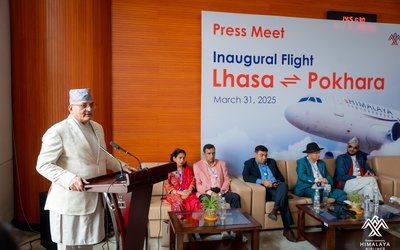
A healthy tourism, the largest forex-earner and revenue generator of the country, is crucial to the wellbeing of the Nepalese economy. In 2013, travel and tourism contributed 7.4% to the Gross Domestic Product.
A talk programme, organized recently by Nepal Tourism Board and Sambahak, entitled Spiritual Tourism in Nepal: Exploring Opportunities and Linkages, took up the topic and discussed how to tap the potential of the tourism sector.
Speaking at the program, chief guest Indian Ambassador to Nepal Ranjit Rae said that infrastructure development was essential to tap the tourism potential in Nepal. He said, “Nepal has many factors on bank on right from Budhha’s birthplace Lumbini to Pashupatinath”.
Setting aside the problems that Nepal Tourism Board (NTB) was facing at the moment, speakers dwelt on a range of issues that spiritual tourism would raise and a host of benefits it could bring.
According to the World Travel and Tourism Council, the contribution of tourism sector to the GDP in Nepal between 2013 and 2023 was estimated to reach 4.5% per annum, surpassing the global average of 4.2% per annum.
Nepal’s tourism economy would have skyrocketed if the untapped potential of the spiritual and religious tourism industry had been harnessed at a faster pace. UNWTO estimates that 300 to 330 million tourists visit the world´s key religious sites every year.
With numerous opportunities such as yoga, meditation and vedic vaastu shastra on offer, Nepal surpasses several tourist hotspots in spiritual attractions. Nepal houses Osho Tapoban, which, in Sanksrit, means a forest for meditation. Apart from this Natural Health Care, Arogya Ashram, in the vicinity has offerings of yogic exercises, classes, herbal therapies and physical therapies.
To cater to the Buddhist tourists from Sri Lanka, Thailand and Japan, the Kopan monastery, Vipasanna form of mediation propounded by Lord Budhha, and Lumbini Gardens offer a tranquil environs for meditation and spiritual quest to connect.
More than 700,000 people flock to Pashupatinath to celebrate one of the holiest festivals of Hindus, the Shivaratri, every year. Of the number, a significant portion of the visitors are Indian tourists. The festival alone generates a decent amount earning for Nepali tourism. Had other prominent occasions and sites been equally promoted, religious tourists would have outnumbered other tourist types. The government needs to consider this in time.
Nepal Tourism Board has to provide the much-needed boost to Lumbini. The city of Lumbini, which has already undergone a makeover, is now left with operating an international airport in Lumbini. This would be a breakthrough in inviting Buddhist tourists directly to the sacred site. Apart from bringing in tourists directly to the city, the airport would play a pivotal role in facilitating direct movement of tourists from South East Asian countries, a major part of the clientele.
Mass marketing in areas with Hindu population in existence, such as India and Bangladesh, needs reach the potentially large number of Hindu tourists. There is a sizeable portion of the Nepalese who are unaware about the spiritual happenings back at home here. It is high time to create information systems that aim to lure in the domestic tourists as well.
Among the many hassles inhibiting the growth of the tourism sector, inept policies and mismanagement are major reasons. The absence of clear-cut and comprehensive national policies cannot bail out the ailing tourism. Policies altered frequently without involving the stakeholders may not be tenable. In addressing the problem, Nepal needs to strengthen the tourism acts and related policies and leave the tourism sector unharmed in spite of political conflicts.
With the tourist season only a while away, the ongoing strikes and lockups in Nepal Tourism Board would worsen the situation, with devastating implications.
Not only spiritual or religious tourism, the entire tourism industry is suffering from the environment pollution. The condition of some temples listed in the cultural heritage has worsened to such an extent that visiting such locales is painstaking. Prompt and drastic actions are required to revive the glory of these deteriorated heritages.
Looking into the unexplored side of tourism, places of great religious importance such as Swargadwari have not been popularized. Even where promotional campaigns have been held, they appear insufficient to tell the visitors enough about the heritages like these. Add to the problem, there is no proper infrastructure and even accessing such places is problematic.
Nepal has been drawing admiration of visitors as the land of Himalayas and the land of majestic beauty. Alongside, spiritual potential of the nation needs to be harnessed and publicized to maximise the revenues from tourism. While formulating the constitution, ample guarantees have to be made to extract the maximum of the Nepalese tourism potential. Just limiting tourism activities to the already popularized areas would generate not much benefit in the long run. Hence the activities for promoting spiritual tourism must be a reflection of sustainable approach to boosting the tourism prospects.

Shalinta Sigdel
Sigdel is a Finance graduate from Stratford University
- Pokhara International Airport and its anticipated gains to the economy
- Apr 21, 2016
- Nepali Constitution and Economy - All’s Not Well
- Sep 26, 2015
- Economic Costs Of Kathmandu Airport Fiasco
- Mar 23, 2015
- Implications Of Fuel Price Fall
- Mar 06, 2015
- Lingering Statute Process: Economic Implications
- Jan 30, 2015















